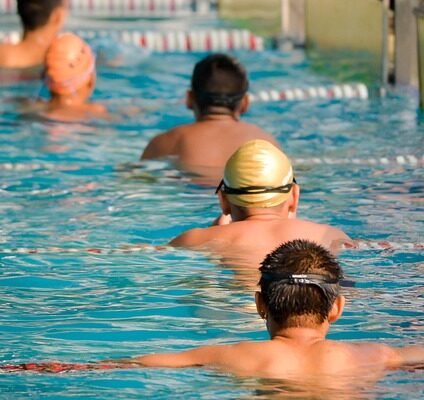If you enjoy walking but want to branch out from your typical routine, water walking is an alternative that can improve your fitness.
This low-impact activity has the ability to provide you with an excellent aerobic workout as well as burn calories while strengthening various muscle groups.
These are the benefits of water walking, how to do it safely, and some variations to try for added fitness benefits.
What are the advantages of walking in the water?
Water has a far higher density than air. Exercising in water takes more work than exercising on land.
Walking in water provides additional resistance, allowing you to push and improve your muscles in ways that a land-based workout would not. Because of additional resistance, it also helps you burn more calories, which might help you lose weight.
Walking on water is a low-impact aerobic activity. This means it’s easier on your bones and joints, making it a better exercise alternative for persons with arthritis, osteoporosis, or fibromyalgia.
Water walking is also a wonderful workout for folks who are
- pregnant
- recuperating from an injury because it puts less pressure and stress on your body.
- everyone who is new to exercising
- elders

A 2015 Trusted Source study also discovered that strolling in water raises your heart rate more than walking on land. This can cause your heart and lungs to work harder.
Water walking may help lower blood pressure, according to another study Trusted Source, especially for persons who are new to fitness. Furthermore, a study of patients with spinal stenosis found that 12 weeks of water walking improved their balance and muscle function.
What do you require?
Water walking doesn’t require much equipment, and most gyms will have it ready for you to use. You may be able to use water treadmills or elliptical machines at some fitness establishments.
If you want to do water walking at a gym or as part of a class, you’ll probably simply need a towel, a swim hat, and, if desired, goggles.
If you intend to go water walking on your own, you should consider purchasing the following items:
- Wrist or ankle weights that are strapped on
- Hand webs or gloves with abrasion resistance
- Dumbbells made of foam
- Weights, resistance gloves, and foam dumbbells can all be purchased online.
Water Walking Techniques
To begin, walk in water that is about waist deep. Maintain appropriate walking form.
Keep your core, and back muscles engaged, your back straight and lengthened, your shoulders back and chin up, your head gazing straight ahead, and your ears above your shoulders.
- Try to keep your torso erect while walking in water without leaning too much forward or to either side.
- Take a deep stride and push into your heel before rolling your weight onto your toes.
- While you walk, swing your arms.
- After you’re comfortable walking in water with proper technique, you can progress to deeper water.
Begin by walking slowly and gradually increasing your pace.
Variations
Once you’ve mastered walking in water, you can add some variety to your practice.
Begin with one lap of each variation and work your way up to two or three laps of each.
Raise Your Knees high
Water walking can be made more intense by raising your knees higher.
It can also assist in working the muscles in your legs, core, glutes, and hip flexors.
To perform this variation:
- Engage your core and raise your right knee as far as possible.
- Raise your left arm at the same time.
- Flip sides and repeat with your left knee and right arm.
Lunges while walking
Walking lunges can strengthen your quadriceps, hamstrings, calves, and glutes. Walk in waist-high water for this exercise variation.
To complete this activity, follow these steps:
- Start with your right foot by taking a step forward.
- Drop your front thigh till it is parallel to the pool’s bottom. Check that your right knee is parallel to but not higher than your ankle. Straighten your back leg.
- Bring your left foot forward, then step forward with your left leg.
Side lunges, rather than forward lunges, are another form of this exercise. Side lunges serve to strengthen the adductor muscles on the inner of your thighs.
Walking sideways
This water walking variation works the muscles in your inner and outer thighs.
To complete this activity, follow these steps:
- Stand on one side, with your right hip leading.
- Take a step to the side with your right foot.
- Bring your left foot into contact with your right.
- Continue in this movement until you reach the pool’s end.
- Return with your left hip leading the way.
Ways to make things Increase Intensity
To increase the intensity of water walking, use foam dumbbells, wrist weights, resistance gloves, or hand webs with any of these movements to give your upper body a more rigorous workout.
You can make a more difficult workout for your lower body by employing ankle weights or walking with a resistance parachute.
Another option to increase the intensity is to jog rather than stroll in the water. You can also undertake interval training by running or jogging for 30 seconds, then walking at your normal pace for a few minutes. You can alternate between the quicker and slower paces for another 5 to 10 minutes.
Safety recommendations
Keep hydrated. While you’re working out in the water, you might not realize how much you’re sweating. It is critical to stay hydrated, especially if the pool is heated.
Be cautious of slick surfaces. Keep an eye out for sharp edges and corners as well. Wearing water shoes may help to prevent slips.
Put on a flotation device. This is especially useful if you’re not a strong swimmer or have trouble with your balance.
Quit if you experience any discomfort. If a movement does not seem natural, do not force it.
Pools that are heated above 90°F (32.2°C) should be avoided. Pools heated to 82 to 88°F (27.8 to 31°C) can help relieve pain, but working out in water heated over that range may be dangerous.
Quit immediately and seek assistance if you experience the following:
- light-headedness or dizziness,
- inability to breathe,
- faintness or weakness,
- pain or pressure in your chest or upper body
- nauseated
- confused
Before beginning a water workout, consult with your doctor, especially if you have any medical issues or take prescription drugs.
To Conclude
Water walking is a fantastic cardio and resistance training activity. It can assist in toning and building various muscle groups while also burning calories and being gentle on your bones and joints.
Begin cautiously and progressively increase the length and intensity of your workouts. You may make it more enjoyable and intriguing by experimenting with different versions and using different equipment. Water walking may become a regular component of your workout program as a result of this.

